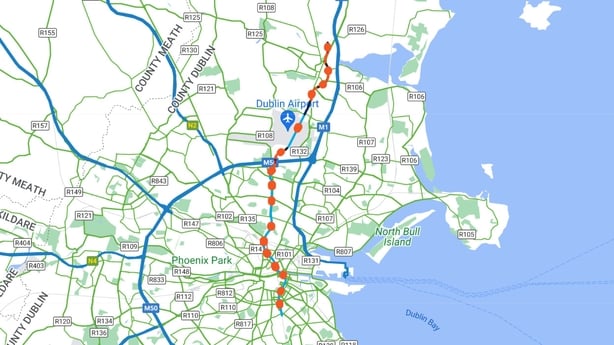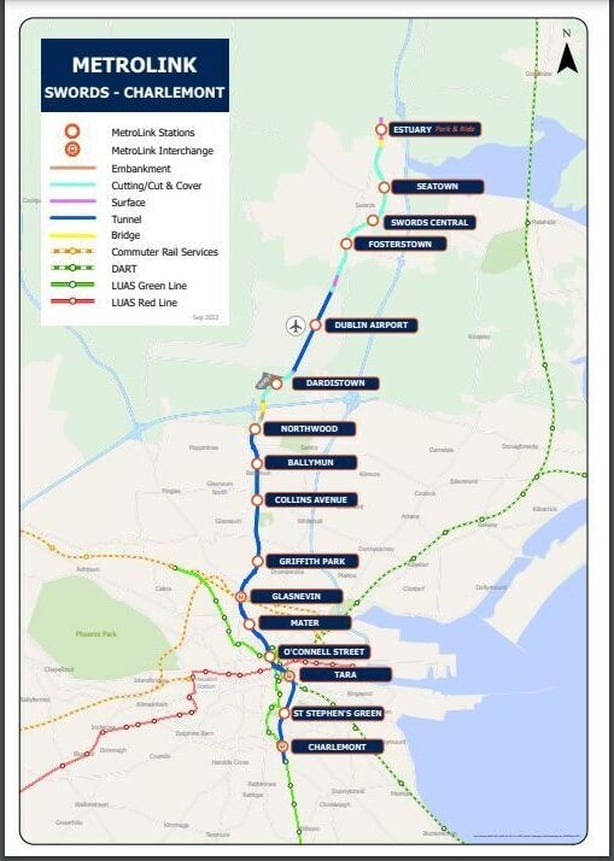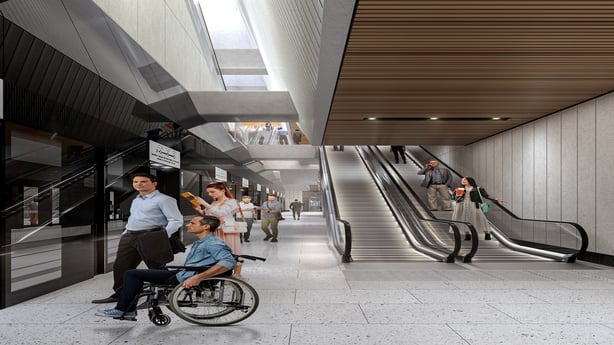The MetroLink is needed for Dublin because Ireland is outgrowing its current transport infrastructure, Transport Infrastructure Ireland has said.
TII also said congestion could cost the Irish economy €2bn per annum in the next decade.
In his opening statement on the first day of An Board Pleanála's oral hearing into the project, MetroLink Project Director Aidan Foley said that in 2021 Dublin was ranked the 35th most congested city in the world and that a single Dublin commuter will, on average, spend over 213 hours a year stuck in traffic
Mr Foley said that in Swords, where the service is due to begin, 8,000 workers currently commute to Dublin city centre, but only 12% use public transport.
He said congestion is reaching critical levels along the Swords-Dublin Airport-Dublin city centre corridor, which he described as a major artery for the Irish economy.
He said journey times from the area can be up to 55 minutes at peak time, compared to off-peak journeys of 25-35 minutes.
The MetroLink will take approximately nine years to complete and Mr Foley said TII recognises that peoples' lives will be disrupted during its construction.
He said TII is satisfied that the tunnel and stations will be constructed at an appropriate depth and using appropriate methodologies to ensure that the buildings above will not suffer significant adverse effects.
Damage to property, if any, will be cosmetic and that they will have appropriate measures in place to monitor adverse changes, including vibration and settlement devices, he said.
Mr Foley’s submission said construction is intrusive and can be disruptive, particularly for those who find themselves near the works, but he said there will be measures to limit noise and vibrations effects including the use of noise blankets and machinery that limit noise and vibrations outputs.
TII has also established a Property Owners Protection Scheme (POPS) in response to concerns by some property owners about possible damage.
This will entitle property owners in certain areas to avail of pre- and post construction survey and have damage up to €45,000 remedied, but these owners can pursue legal claims if they wish.
It said around 17% of property owners in the qualifying areas have signed up for the scheme.
TII also has a communications plan in place to provide information to the public and those impacted by the project, including visitor information centres and monthly meetings with those along the route.

Since 2018, TII said it has also engaged in a number of public consultations about the preferred route and made a number of amendments to the plans as a result of the feedback received.
Around 200 people attended the opening day of the oral hearing in Dublin’s Gresham Hotel.

Green Party MEP for Dublin Ciaran Cuffe and Labour TD for Dublin Fingal Duncan Smith were among those in attendance for today's hearing.
Details of the proposed rail link between Swords and Dublin city centre will be outlined at the hearing over the next five weeks.
Construction of the underground rail link, which was first mooted more than 20 years ago, is intended to commence in 2025, take around a decade and is expected to cost at least €9.5 billion.
Transport Infrastructure Ireland said MetroLink will allow 53 million passengers a year to travel from Swords in north Dublin to Charlemont in Dublin's south city centre in just 25 minutes
Trains running every 90 seconds will carry 20,000 passengers an hour in each direction and most of the almost 19km route will run underground along 16 new stations serving communities in Swords, Ballymun, Glasnevin and Ranelagh.
More than 300 submissions have been made since the Draft Railway Order was lodged in September 2022.
The oral hearing is expected to outline the concerns of some about the project, including a number of homeowners, Trinity College Dublin and the Office of Public Works.
The project's design team has produced more than 3,000 separate drawings and has delivered 2,500 information packs to property owners that will be impacted by the project.
The stops have been named Estuary, Seatown, Swords Central, Fosterstown, Dublin Airport, Dardistown, Northwood, Ballymun, Collins Avenue, Griffith Park, Glasnevin, Mater, O'Connell Street, Tara, St Stephen's Green and Charlemont.
The project will also involve the construction of a new 99-metre long bridge over the M50 and a 260-metre long viaduct over the Broadmeadow and Ward River.

A 3,000-space multi-storey park and ride facility near the M1, a proposed first stop at Estuary Station and a maintenance depot located near the proposed Dardistown Station will also part of the project.
A rail link between Dublin Airport and the city centre was first mooted around 2002 and the project became known as Metro North.
It was resurrected again in 2018 and rebranded at MetroLink with a proposed completion date of 2027 and a estimated cost of €3 billion.
Around €300m has been spent on Dublin's various Metro projects to date.
Last year, Secretary General of the Department of Transport Ken Spratt said that the spend on the current MetroLink project to the end of March 2023 was €115.3m.
At that time, Mr Spratt said that €9.5 billion was considered the most likely cost for MetroLink project.
Acquisition of properties
The construction of MetroLink will require the acquisition of a substantial number of residential and commercial properties along with numerous land and property interests in both public and private ownership.
Some will have to be acquired permanently and others temporarily during the construction phase.
If the project is approved, Compulsory Purchase Orders will be used and TII said the acquisition of these properties and land is proportionate to the public interest of the project.
TII said it already has and will continue to consult with property owners ahead of permission being granted for the project.
It said it will index link the price it agrees to pay residential property owners for their property if the property values rise, but if the values drop there will be no downward adjustment.
TII said it will also cover all reasonable professional fees involved in the transaction and assist with sourcing alternative accommodation.
For those renting affected properties, TII said it will engage a letting agent to help them to identify new tenancies and they will cover moving expenses including paying the rent of the tenancy for up to a year.
TII said it will also help any impacted businesses to relocate and it will give them as long as is possible to make this move.
Earlier the hearing was told that the construction would have a profound effect on the gate lodge at Santry Lodge, an 18th century property located off the Old Ballymun Road in north Dublin which is now used as homeless accommodation.
This impact is greater than previously assessed due to the designation of the property being upgraded to a protected structure.
It said it will now record the derelict lodge at a more detailed level due to this.
The hearing was also told that plans for Metrolink were mainly in keeping with the Government's climate action targets and the Dublin City and Fingal developments plans.
It said it was of strategic importance to the long term development of the Dublin region.
And it said some impacts, such as the demolition of the Markievicz Leisure Centre in the south city will be mitigated by rebuilding the facility at a different location.
Fingal County Council told the hearing that it supports the Metrolink project with Róisín Burke saying the council believes Fingal will be transformed by the project.
Dublin City Council said it also supports the Metrolink and the benefits it will bring to the city. Dublin City Planner Deirdre Scully said Metrolink will improve both the pedestrian and cycling experience in the city core and approach routes to the city.
An Taisce said that Metrolink should not be used as a reason to increase capacity at Dublin Airport and that cost controls need to be considered due to the experience at the National Children's Hospital.
Ian Lumley said the business case for Metrolink should not include serving increased capacity to Dublin Airport: "It's clearly hugely problematic and in conflict with our national and international climate targets."
The heritage body also said that plans to demolish 70 apartments at the College Gate complex just off Pearse Street and the Markievicz Leisure Centre should be reconsidered due to the housing crisis.
The Office of Public Works was represented at the hearing by Chartered Town Planner John Downey.
He said while the OPW wished to express its overall support for the Metrolink project, they also have to ensure the protection and preservation of a number of important State properties and national monuments including 14-17 Moore Street, the GPO, the National Library, Leinster House, the National Museum of Archeology, and St Stephen's Green.







